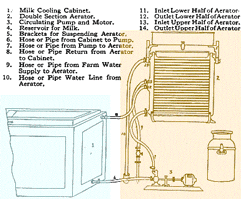Changing Lives
Chilling Out is an interactive exhibit about the household refrigerator and how it changed our way of life.
The Challenge of Keeping Food Fresh and Edible
For hundreds of years in Canada, staple foods – especially those available year-round – were restricted to non-perishable grains, vegetables and dried or cured meats and smoked fish. Perishable foods had to be consumed quickly before decomposition occurred. Foods such as milk, cream, meat, fish, fresh fruit, and vegetables could not be stored for long or transported over great distances.
Why? Foods with a high water, sugar or protein content are a premium culture medium for fungi and bacteria that are widespread in the environment. Microorganisms, either present on the food since production or carried to it as air-borne spores, begin growth on exposed surfaces and multiply rapidly at room temperatures. For these microorganisms, the food is a source of energy – and fouling it with metabolic by-products results in rapid decomposition of the food. Decomposing food is degraded in odour, texture and taste and may even harbour poisonous compounds.
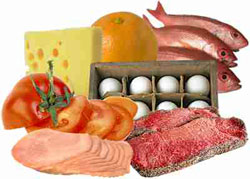
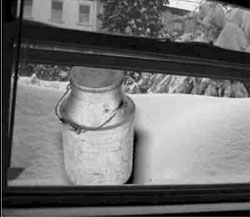
Winter … Canada’s Natural Refrigeration System
Just a few generations ago, winter served as a natural refrigeration system for countless Canadians. Because perishable foods were kept at low temperatures, the process of decomposition was substantially slowed. In winter, perishable foods could be kept fresh (free from decomposition) for days at a time by storage in protected areas (like a cold cellar) or on a snowy windowsill. Sometimes perishable foods were kept in a waterproof container submerged in a cold, fast-flowing stream. But the use of natural, winter-cooled food storage was too often inconvenient and unreliable because of the danger of an unexpected thaw.
The Ice Box: Using Ice to Keep Food Fresh
Winter cold could be brought indoors by putting a block of ice into an insulated box.
The ice absorbed heat from the food to keep it cold and free from decomposition while the insulated sides of the box prevented warm air in the room from rapidly melting the ice.
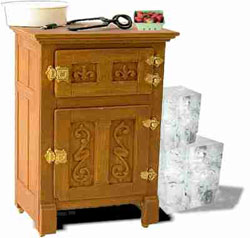
Harvesting Winter Ice … Ice harvested in winter could be saved to cool food in summer.
In Canada, there was always plenty of natural ice in winter. By the early twentieth century the demand for ice to keep food fresh in Canadian homes was so great, it had fostered an ice harvesting industry.
Each winter, after waiting for the ice to thicken, large saws were used to cut out large blocks of ice that were hoisted onto horse-drawn wagons.
The harvested ice was then dragged back onto land and stored. Smaller blocks were cut and delivered to homes throughout Canadian cities, towns, and rural areas. Ice harvesting and delivery employed thousands of Canadians. An unusually warm winter, however, limited the supply of ice and resulted in higher costs, unemployment, and other economic challenges.
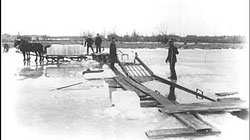
Keeping Winter’s Ice Through the Summer … Ice blocks were buried in sawdust to provide insulation against summer heat.
Before the advent of mechanical refrigeration, the only way to keep food fresh in Canadian homes during the summer was to stockpile large quantities of winter harvested ice in insulated storage rooms.
Produced in quantity as a by-product of the Canadian forestry and lumber industry, sawdust was an inexpensive commonly used summer insulator of winter-harvested ice. Ice blocks were stacked in large piles in warehouses and covered with a thick layer of sawdust. During the summer, and as stored ice was needed to supply the domestic market, workers dug into the sawdust piles and retrieved the valuable commodity preserved within.
Though some melting did take place, the combination of large ice stockpiles and insulation ensured that winter ice would remain available right through until the following winter season.
The whole process could also be replicated on a smaller scale. Farms producing perishable foods often had their own small ice houses to keep ice through the summer for their own consumption. On dairy farms, for instance, milk cans were kept in a tank filled with iced water.
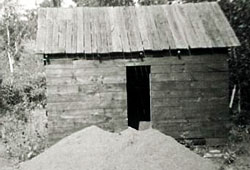
The Iceman Cometh … Before refrigerators, many households ordered ice delivery several times a week.
Ice storage and supply companies drew on their warehouses of insulated winter ice to supply the domestic market. From central distribution depots, horse-drawn vans were sent out daily on extensive rural, town and city distribution routes. The horses proceeded from home to home, often having memorized the whole route that they followed each day.
If the household had a sign in the window indicating that ice was needed, a large pair of ice tongs was used to hoist a block of ice onto the delivery person’s leather-aproned back and taken right into the kitchen where the new block could be placed inside the ice box.
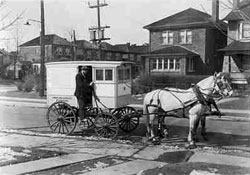
The Trouble with Ice Boxes … Ice boxes were messy and not very efficient at keeping food cold.
When ice was first delivered, it cooled the food storage chamber well, although temperatures were never lower than several degrees above freezing right beside the ice block. Closer to the walls of the cabinet, temperatures were still higher.
Over the next day or two, heat absorbed from food and the walls of the container slowly melted the ice block. As the block got smaller and smaller, the temperature inside the food storage chamber slowly began to rise. As a result, food storage temperatures fluctuated from day to day.
The processes of ice melting and food warming up were speeded up enormously every time the ice box door was opened.
Water from the melting ice trickled down through a tube leading from the ice rack to the bottom of the ice box. The melt water pan that stood on the floor under the ice box had to be emptied once or twice a day.
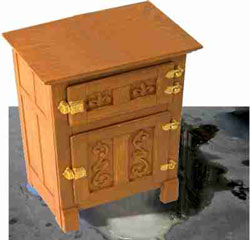
Living With an Ice Box … The ice box needed constant attention.
An Ice Today sign and the daily task of emptying the water were characteristic of a home with an ice box. The ice box required a good deal of daily attention from the householder to avoid spoiling food, especially during summer temperatures.

The Arrival of Mechanical Refrigeration … Artificial cooling brought new control to food storage.
As the technology improved, mechanical refrigeration units became small enough for commercial food-handling operations like dairying and meat packing. But they still required a lot of space.
The benefits of mechanical refrigeration for the safe handling, storage and shipment of perishable foods meant an increasing demand. Never before could temperatures be held so low and with such consistency and reliability.
